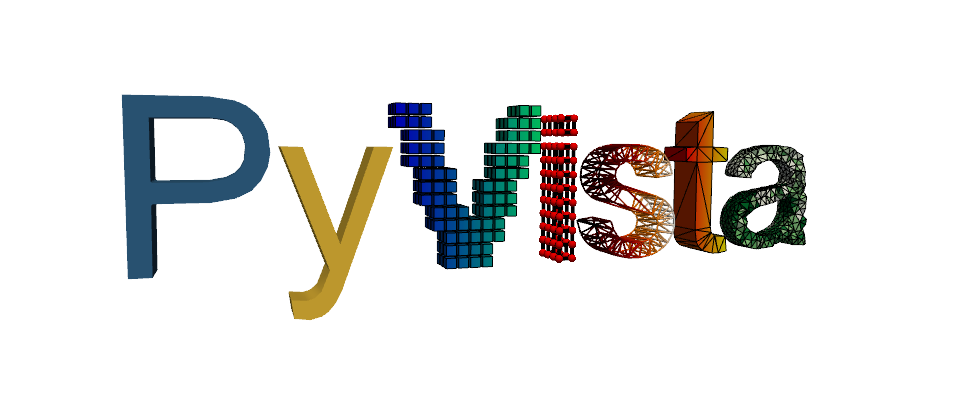注釈
完全なサンプルコードをダウンロードしたり、Binderを使ってブラウザでこのサンプルを実行するには、 最後に進んでください 。
平面とボックスでクリップします#
平面またはボックスを使用してデータセットをクリップ/カットします.
import pyvista as pv
from pyvista import examples
平面付きクリップ#
pyvista.DataSetFilters.clip() フィルタを使用したユーザ定義平面によるデータセットのクリップ
help(dataset.clip)
Help on method clip in module pyvista.core.filters.data_object:
clip(normal: 'VectorLike[float] | NormalsLiteral' = 'x', origin: 'VectorLike[float] | None' = None, invert: 'bool' = True, value: 'float' = 0.0, inplace: 'bool' = False, return_clipped: 'bool' = False, progress_bar: 'bool' = False, crinkle: 'bool' = False) method of pyvista.core.pointset.PolyData instance
Clip a dataset by a plane by specifying the origin and normal.
If no parameters are given the clip will occur in the center
of that dataset.
Parameters
----------
normal : tuple(float) | str, default: 'x'
Length 3 tuple for the normal vector direction. Can also
be specified as a string conventional direction such as
``'x'`` for ``(1, 0, 0)`` or ``'-x'`` for ``(-1, 0, 0)``, etc.
origin : sequence[float], optional
The center ``(x, y, z)`` coordinate of the plane on which the clip
occurs. The default is the center of the dataset.
invert : bool, default: True
Flag on whether to flip/invert the clip.
value : float, default: 0.0
Set the clipping value along the normal direction.
inplace : bool, default: False
Updates mesh in-place.
return_clipped : bool, default: False
Return both unclipped and clipped parts of the dataset.
progress_bar : bool, default: False
Display a progress bar to indicate progress.
crinkle : bool, default: False
Crinkle the clip by extracting the entire cells along the
clip. This adds the ``"cell_ids"`` array to the ``cell_data``
attribute that tracks the original cell IDs of the original
dataset.
Returns
-------
pyvista.PolyData | tuple[pyvista.PolyData]
Clipped mesh when ``return_clipped=False``,
otherwise a tuple containing the unclipped and clipped datasets.
Examples
--------
Clip a cube along the +X direction. ``triangulate`` is used as
the cube is initially composed of quadrilateral faces and
subdivide only works on triangles.
>>> import pyvista as pv
>>> cube = pv.Cube().triangulate().subdivide(3)
>>> clipped_cube = cube.clip()
>>> clipped_cube.plot()
Clip a cube in the +Z direction. This leaves half a cube
below the XY plane.
>>> import pyvista as pv
>>> cube = pv.Cube().triangulate().subdivide(3)
>>> clipped_cube = cube.clip('z')
>>> clipped_cube.plot()
See :ref:`clip_with_surface_example` for more examples using this filter.
Y軸法線によるクリップを実行する
clipped = dataset.clip("y", invert=False)
clipped
結果をプロットします.
pl = pv.Plotter()
pl.add_mesh(dataset, style="wireframe", color="blue", label="Input")
pl.add_mesh(clipped, label="Clipped")
pl.add_legend()
pl.camera_position = [(0.24, 0.32, 0.7), (0.02, 0.03, -0.02), (-0.12, 0.93, -0.34)]
pl.show()

境界付きクリップ#
pyvista.DataSetFilters.clip_box() フィルタを使用して,XYZ境界のセットによってデータセットをクリップします.
まず,例のデータセットをダウンロードします.
dataset = examples.download_office()
help(dataset.clip_box)
Help on method clip_box in module pyvista.core.filters.data_object:
clip_box(bounds: 'float | VectorLike[float] | pyvista.PolyData | None' = None, invert: 'bool' = True, factor: 'float' = 0.35, progress_bar: 'bool' = False, merge_points: 'bool' = True, crinkle: 'bool' = False) method of pyvista.core.pointset.StructuredGrid instance
Clip a dataset by a bounding box defined by the bounds.
If no bounds are given, a corner of the dataset bounds will be removed.
Parameters
----------
bounds : sequence[float], optional
Length 6 sequence of floats: ``(x_min, x_max, y_min, y_max, z_min, z_max)``.
Length 3 sequence of floats: distances from the min coordinate of
of the input mesh. Single float value: uniform distance from the
min coordinate. Length 12 sequence of length 3 sequence of floats:
a plane collection (normal, center, ...).
:class:`pyvista.PolyData`: if a poly mesh is passed that represents
a box with 6 faces that all form a standard box, then planes will
be extracted from the box to define the clipping region.
invert : bool, default: True
Flag on whether to flip/invert the clip.
factor : float, default: 0.35
If bounds are not given this is the factor along each axis to
extract the default box.
progress_bar : bool, default: False
Display a progress bar to indicate progress.
merge_points : bool, default: True
If ``True``, coinciding points of independently defined mesh
elements will be merged.
crinkle : bool, default: False
Crinkle the clip by extracting the entire cells along the
clip. This adds the ``"cell_ids"`` array to the ``cell_data``
attribute that tracks the original cell IDs of the original
dataset.
Returns
-------
pyvista.UnstructuredGrid
Clipped dataset.
Examples
--------
Clip a corner of a cube. The bounds of a cube are normally
``[-0.5, 0.5, -0.5, 0.5, -0.5, 0.5]``, and this removes 1/8 of
the cube's surface.
>>> import pyvista as pv
>>> cube = pv.Cube().triangulate().subdivide(3)
>>> clipped_cube = cube.clip_box([0, 1, 0, 1, 0, 1])
>>> clipped_cube.plot()
See :ref:`clip_with_plane_box_example` for more examples using this filter.
bounds (xmin, xmax, ymin, ymax, zmin, zmax) で定義されるバウンディングボックスでデータセットを切り取ります.
bounds = [2, 4.5, 2, 4.5, 1, 3]
clipped = dataset.clip_box(bounds)
clipped
元のデータセットと切り取られたデータセットをプロットします.
pl = pv.Plotter()
pl.add_mesh(dataset, style="wireframe", color="blue", label="Input")
pl.add_mesh(clipped, label="Clipped")
pl.add_legend()
pl.show()

回転ボックス付きクリップ#
pyvista.DataSetFilters.clip_box() フィルタを使用して任意に回転したソリッドボックスでデータセットをクリップします.
mesh = examples.load_airplane()
# Use `pv.Box()` or `pv.Cube()` to create a region of interest
roi = pv.Cube(center=(0.9e3, 0.2e3, mesh.center[2]), x_length=500, y_length=500, z_length=500)
roi.rotate_z(33, inplace=True)
pl = pv.Plotter()
pl.add_mesh(roi, opacity=0.75, color="red")
pl.add_mesh(mesh, opacity=0.5)
pl.show()

定義されたボックスのジオメトリを使用して,ボックスクリッピングアルゴリズムを実行します.
extracted = mesh.clip_box(roi, invert=False)
pl = pv.Plotter(shape=(1, 2))
pl.add_mesh(roi, opacity=0.75, color="red")
pl.add_mesh(mesh)
pl.subplot(0, 1)
pl.add_mesh(extracted)
pl.add_mesh(roi, opacity=0.75, color="red")
pl.link_views()
pl.view_isometric()
pl.show()

しわくちゃなクリッピング#
クリンプクリッピングは,クリップフィルタが境界上のセルを本当にクリップするのではなく,入力セルの構造を保持し,セル全体を境界から通過させたい場合に有効です.
このオプションは pyvista.DataSetFilters.clip(), pyvista.DataSetFilters.clip_box(), pyvista.DataSetFilters.clip_sruface() で使用できますが, pyvista.DataSetFilters.clip_scalar() でスカラーによるクリッピングを行っても利用することはできません.
# Input mesh
mesh = pv.Wavelet()
クリッピングプレーンの定義
標準クリップを実行します
クリンプクリップを行い,比較する
プロット比較
pl = pv.Plotter(shape=(1, 2))
pl.add_mesh(clipped, show_edges=True)
pl.add_mesh(plane.extract_feature_edges(), color="r")
pl.subplot(0, 1)
pl.add_mesh(crinkled, show_edges=True)
pl.add_mesh(plane.extract_feature_edges(), color="r")
pl.link_views()
pl.show()

Total running time of the script: (0 minutes 2.595 seconds)
